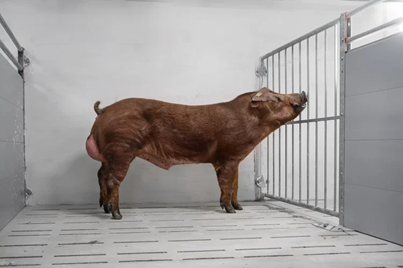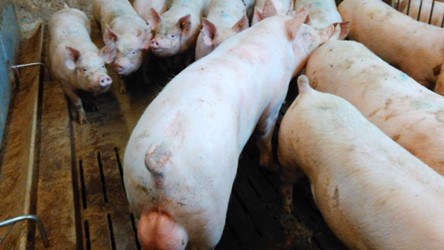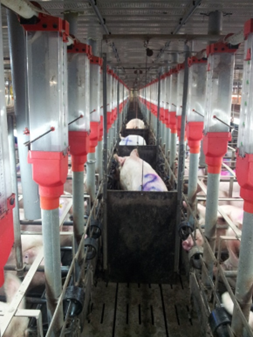
19.06.2023
The quality of heat detection in gilts depends on four fundamental things:
If any of these bases are not in order, then there are problems with heat detection of gilts.
Today we will talk about boars since, in my experience, the problem with their quality and exploitation occurs in 8 out of 10 farms.
The better the quality of the heat detection boar, the higher the percentage of detection of gilts in heat. Characteristics that determine its quality:
 Picture 1: Otrada GTC
Picture 1: Otrada GTC
If the boar does not match the description above, then the detectability of sows and gilts coming into heat in the herd is sharply reduced.
Below is a table where it was experimentally determined that the percentage of heat detection is the highest when an active boar works with gilts. The effective rate is reduced when using only the sound of a boar, its scent, or a combination of both.
Effectiveness of Various Stimuli in Releasing the Postural Standing Reaction of Oestrous Sow
Stimulation | Postural standing reaction (%) |
Pressure on back only | 48% |
Broadcasting boar’s courting grunts | 70% |
Odor of preputial secretion at 40°C | 80% |
Smell and sound of boar | 90% |
Smell, sound and sight of boar | 97% |
Signoret et al 1975
When detecting heat in group pens, accompany a boar there, let him adapt for 3-4 minutes while working with the gilts, and only then enter the pen. The boar should be fed an hour and a half before detection. Otherwise, instead of stimulating the gilts, the animal will look for feeders with food.

An approximate calculation of the duration of active work of the heat detection boars is 30–40 minutes, after which it should be replaced with another one. You should always approach the situation individually, and there are cases that the boar is actively working for longer.
Keeping heat detection boars in the insemination sector and with gilts is not recommended, as gilts get used to its scent and sound and react poorly to it during stimulation. They will perceive him as "one of the family members" and not respond to his pheromones and scent. The study’s results clearly show the dependence on the heat's arrival and detectability to the boars' location.
Boar’s location | Percentage gilt's on the heat detection |
In the insemination section | 80% |
In another section | 97% |
KNOX et al 2004
If the design of the farm does not allow you to move the boars to another place, then rotate the boars between sections: the boar from section No. 1 works in section No. 2 and vice versa.
The number of heat detection boars in a herd can vary, depending on the quality of the animals and the design of the farm and sections. In total, one detection boar is calculated for 250 sows.
When you detect estrus and stimulate gilts in individual pens, using 2-3 heat detection boars simultaneously is recommended, so the gilt’s heat detection will be higher. Try to combine pairs: at the beginning, let in an active and energetic boar, and after a calmer one, or vice versa. Give the gilts more choices.


The boar must be in contact with each gilt for at least 30-40 seconds face-to-face; otherwise, the quality of the gilt’s detection is reduced. Therefore, we advise the stock person to use a basic watch with a stopwatch to fix the time.

Rotate boars throughout the day by sectors: problem sows, gilts, and the insemination sector.
If the number of boars limits you, their schedule should be arranged as follows: first, work with gilts, then with the problem sows, and finally, with the main herd. For the first two sections, the boar must exert more effort and energy than he will with the weaned sows.
From the moment the boars arrive at the farm, they should be trained well:
The basic rule of working with heat detection boars is that the animal does 70% of the work, and the stock person does 30%. If the scheme works contrary to that split, it is worth reviewing the internal work procedures and SOPs (standard operating procedures).

Pash Tetiana
Technical Sales Manager, DVM
+33 6 30 01 51 68
